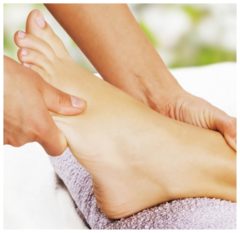The human foot is a masterpiece of engineering and a work of art.
-Leonardo da Vinci
Reflexology is an integrative health practice that maps a reflection of the body, predominately on the feet, hands and head. It uses unique manual techniques to deliver pressure to neural pathways assisting the body to function optimally.
What is a Reflexologist?
A Reflexologist is a person who uses special pressure techniques on the reflexes of the feet, hands, and ears; one who has studied the principles of Reflexology, anatomy, and physiology and who has received a minimum 110 hour training certificate or diploma of education in Reflexology, or certification through a national, independent non-profit Reflexology certification board.
Scope of Practice
Specific techniques and areas of application define the unique quality of Reflexology as opposed to any other practice. The traditional practice of Reflexology primarily focuses on the theory of reflex maps and their representation on the feet, hands, and ears. Reflexology as a manual practice consists of working with specific finger, thumb, and hand techniques in order to stimulate reflex points on the feet, hands, and ears. Reflexology is applied to a fully clothed person, only the shoes and socks are removed.
Legislation
Reflexology Is Exempt from the Arizona Massage Therapy Law.
Reflexology is exempt through scope of practice from the 2004 Arizona Massage Therapy Law SB 1103, Chapter 42, Massage Therapy, Article I. General Provisions, 32- 4201, Definitions, paragraph 5a: The manual application of compression, stretch, vibration or mobilization of the organs and tissues beneath the dermis, including the components of the musculoskeletal system, peripheral vessels of the circulatory system and fascia, when applied primarily to parts of the body other than the hands, feet, and head. View Here
History of Reflexology
Many forms of footwork have been known and used throughout human history in Egypt, India, China, Japan, the European countries and the North and South Americas. In 1909 – 1913 Dr. William FitzGerald, an American medical doctor, began introducing a new therapy to the west known as “Zone Therapy”. He noted that reflex areas on the feet and hands were linked to other areas and organs of the body within the same longitudinal zone (FitzGerald Zones). He noted that zone therapy brought pain relief to his patients.
• Dr. Joe Shelby Riley, a student of Dr. FitzGerald’s, added to FitzGerald’s
longitudinal lines with his discovery of the eight horizontal lines and also made the first drawings of the reflex points located on the feet and hands, and he was the first to add the ears. Dr. Riley published the first book on “Zone Therapy” in 1919. Altogether, he wrote four books (twelve editions) and several correspondence courses on the subject.
• In the 1930’s to the mid 70’s, Eunice D. Ingham, a Physiotherapist in Dr. Riley’s office, further developed zone theory and renamed it “Reflexology”. Through her study and work on many clients, she observed that congestion or tension in any part of the foot is mirrored in the corresponding part of the body and created detailed “reflex maps” of the reflex points on the feet. She also discovered that an alternating pressure was more effective than continuous pressure and created the “thumb walk” technique.
• In 1938 Eunice published her first book, Stories the Feet Can Tell and began a 40 year lecturing and teaching career that took her across the US and many parts of Europe. In 1945: “Zone Therapy” and “Gland Reflexes” was published. Later the two books were combined and renamed “Stories the Feet Can Tell” and “Stories the Feet Have Told”. Eunice’s work and legacy lives on through her books and the Original Ingham Method™ by nephew Dwight Byers of the International Institute of Reflexology.
• To learn more about Reflexology’s history read “Reflexology: Art, Science & History and Eunice Ingham”; A Biography by Christine Issel.
